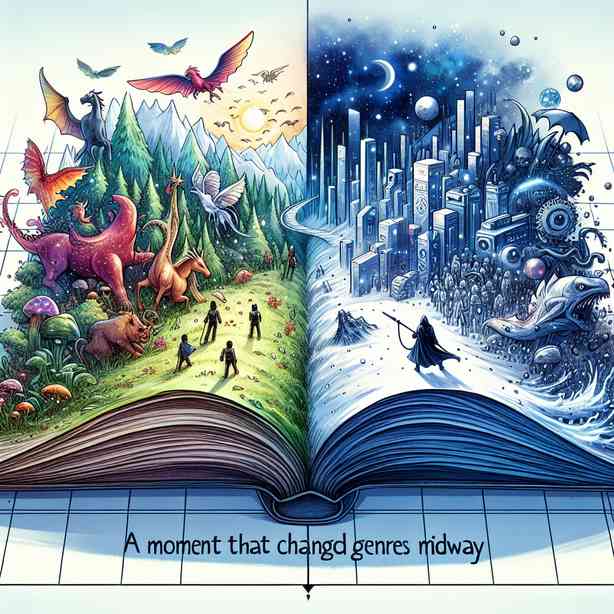
Genres in literature, music, and film are fluid entities, constantly evolving as creators explore new ideas, themes, and techniques. However, there are pivotal moments in the history of these genres that irrevocably alter their course. One such moment that fundamentally changed genres occurred in the middle of the 20th century, marking a significant turning point in artistic expression. By examining this moment, we can gain insight into how creativity flourishes in the face of constraints, and how new waves of thought can reshape conventions.
The mid-20th century was a significant period characterized by rapid social change and technological advancements. In literature, this era saw the rise of postmodernism, a genre that challenged the norms established by modernism. Postmodernism emerged as a reaction to the pessimism and disillusionment prevalent in the aftermath of World War II. The war had shattered old narratives, leaving artists to grapple with existential questions and a sense of instability. This resulted in a new wave of literature that blurred the lines between reality and fiction, questioning the idea of absolute truth and embracing ambiguity.
A key moment in this transformation was the publication of works like Thomas Pynchon’s “Gravity’s Rainbow” in 1973. This novel exemplified the postmodern tendency to become fragmented and non-linear, diving into complex themes of paranoia and the influence of technology on society. Its intricate structure and dense narrative challenged readers’ perceptions, inviting them to engage with the text in unconventional ways. This shift not only redefined literary expectations but also spurred a broader exploration of genre in literature. Genres became less rigid, opening doors to hybrid forms that combined elements of science fiction, fantasy, and realism, among others.
In the realm of music, the emergence of rock ‘n’ roll in the 1950s marked a transformative moment that blended various genres, including blues, jazz, and country. Artists like Chuck Berry and Elvis Presley captured the youthful spirit of the time, infusing traditional music styles with new energy and distinct cultural attitudes. The electrifying performances and rebellious themes associated with rock ‘n’ roll resonated deeply with the youth, laying the groundwork for future artists who would challenge the status quo. This genre not only influenced popular music but also left an indelible mark on culture, fashion, and societal norms.
The influence of rock ‘n’ roll did not stop there; it inspired a wave of experimentation and boundary-pushing that would lead to the evolution of sub-genres such as punk, metal, and alternative rock. Each of these movements brought its unique flair, often reflecting the socio-political climate of the times. For instance, punk rock emerged in the 1970s as a rebellion against the mainstream music industry, characterized by its raw sound and anti-establishment messages. Artists like the Sex Pistols and The Ramones used their music as a form of protest, encapsulating a broader anti-authoritarian sentiment that resonated with disillusioned youth. This evolution of genre created a rich tapestry of sounds and styles, each borrowing elements from predecessors while forging new paths of artistic expression.
In the realm of visual arts, the introduction of concepts such as abstract expressionism during the mid-20th century was instrumental in reshaping the genre. Artists like Jackson Pollock and Mark Rothko pushed the boundaries of traditional representation, focusing on the emotional experience of art rather than its literal subject matter. This radical departure from conventional techniques inspired subsequent movements such as minimalism and conceptual art, prompting a reevaluation of what could be classified as art. The exploration of abstraction invited artists across various disciplines to challenge their own creative limitations and seek innovative ways to communicate their vision.
Moreover, the technological advancements of the period cannot be overlooked. The invention of new mediums such as video art opened doors for artists to explore narrative and performance in innovative ways. Pioneers like Nam June Paik utilized television as a medium for artistic expression, merging elements of art, technology, and popular culture. This cross-pollination of genres expanded the landscape of contemporary art and encouraged a more inclusive approach to creativity.
As we examine these transformative moments across various genres, it’s clear that the intersection of social change, technological innovation, and artistic exploration serves as a catalyst for evolution. The mid-20th century exemplified a period where boundaries were increasingly blurred, allowing for the creation of new forms and styles that resonate with audiences worldwide. This spirit of innovation continues to inspire contemporary artists and creators, fostering a culture of experimentation that encourages divergence from conventional expectations.
In conclusion, the moment that changed genres midway through the 20th century represents a significant turning point in artistic expression. By embracing the complexities of human experience and challenging established norms, artists across literature, music, visual arts, and beyond have carved out new pathways for creativity. This legacy of innovation not only enriches our understanding of genres but also underscores the importance of adaptability and openness to change in the arts. As we look to the future, we can remain committed to exploring the limitless possibilities that arise when we dare to redefine the conventions of our chosen fields. Each moment of transformation serves as a reminder that art, in all its forms, is a reflection of the world around us, perpetually evolving and reshaping our collective experience.


